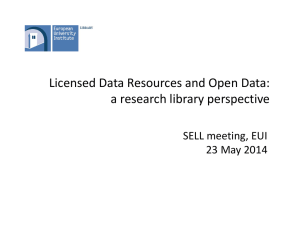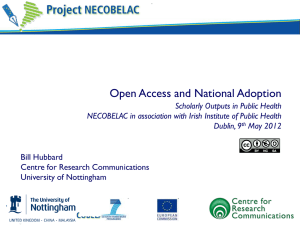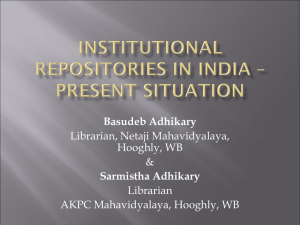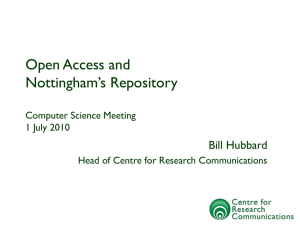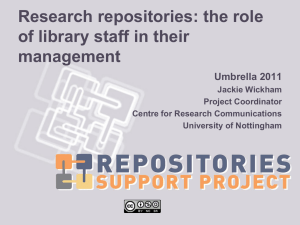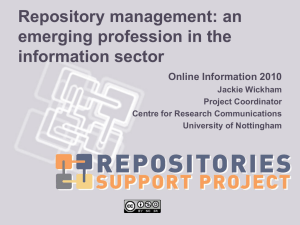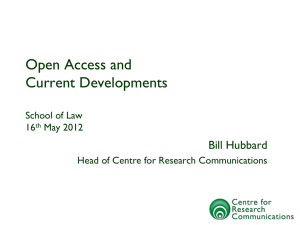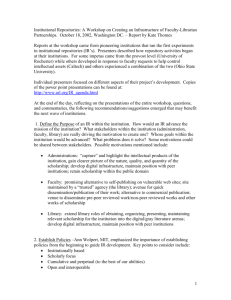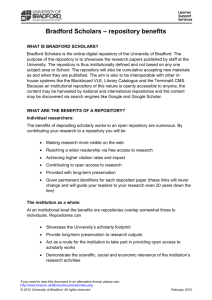Assessing the Value of Computer Science Course Material
advertisement
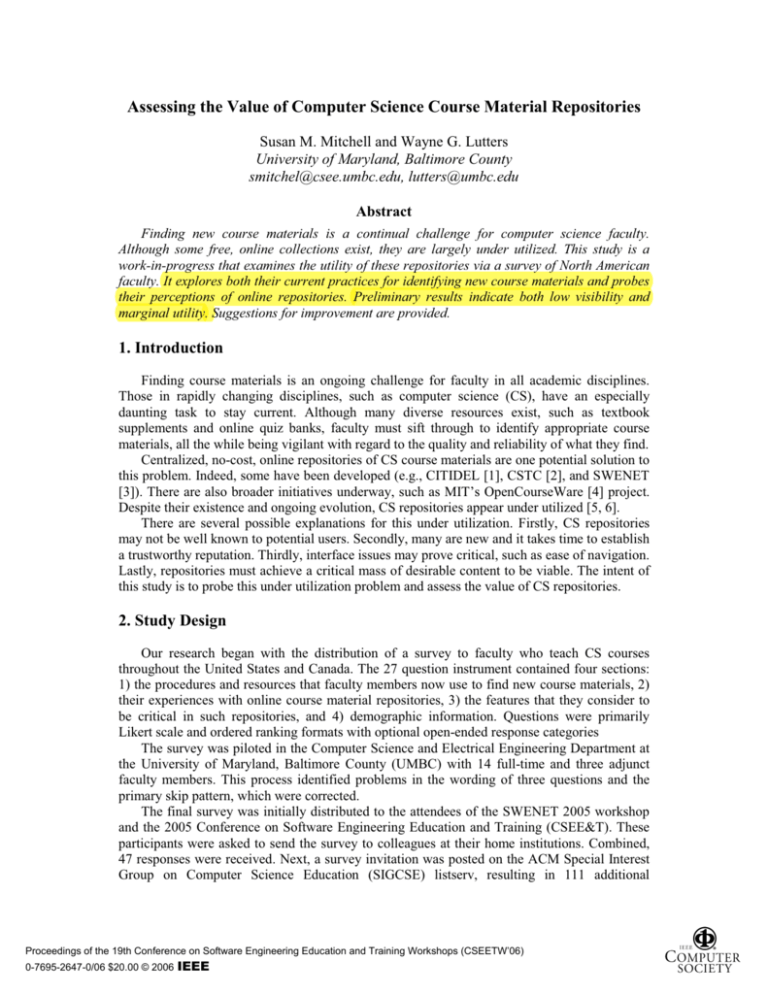
Assessing the Value of Computer Science Course Material Repositories
Susan M. Mitchell and Wayne G. Lutters
University of Maryland, Baltimore County
smitchel@csee.umbc.edu, lutters@umbc.edu
Abstract
Finding new course materials is a continual challenge for computer science faculty.
Although some free, online collections exist, they are largely under utilized. This study is a
work-in-progress that examines the utility of these repositories via a survey of North American
faculty. It explores both their current practices for identifying new course materials and probes
their perceptions of online repositories. Preliminary results indicate both low visibility and
marginal utility. Suggestions for improvement are provided.
1. Introduction
Finding course materials is an ongoing challenge for faculty in all academic disciplines.
Those in rapidly changing disciplines, such as computer science (CS), have an especially
daunting task to stay current. Although many diverse resources exist, such as textbook
supplements and online quiz banks, faculty must sift through to identify appropriate course
materials, all the while being vigilant with regard to the quality and reliability of what they find.
Centralized, no-cost, online repositories of CS course materials are one potential solution to
this problem. Indeed, some have been developed (e.g., CITIDEL [1], CSTC [2], and SWENET
[3]). There are also broader initiatives underway, such as MIT’s OpenCourseWare [4] project.
Despite their existence and ongoing evolution, CS repositories appear under utilized [5, 6].
There are several possible explanations for this under utilization. Firstly, CS repositories
may not be well known to potential users. Secondly, many are new and it takes time to establish
a trustworthy reputation. Thirdly, interface issues may prove critical, such as ease of navigation.
Lastly, repositories must achieve a critical mass of desirable content to be viable. The intent of
this study is to probe this under utilization problem and assess the value of CS repositories.
2. Study Design
Our research began with the distribution of a survey to faculty who teach CS courses
throughout the United States and Canada. The 27 question instrument contained four sections:
1) the procedures and resources that faculty members now use to find new course materials, 2)
their experiences with online course material repositories, 3) the features that they consider to
be critical in such repositories, and 4) demographic information. Questions were primarily
Likert scale and ordered ranking formats with optional open-ended response categories
The survey was piloted in the Computer Science and Electrical Engineering Department at
the University of Maryland, Baltimore County (UMBC) with 14 full-time and three adjunct
faculty members. This process identified problems in the wording of three questions and the
primary skip pattern, which were corrected.
The final survey was initially distributed to the attendees of the SWENET 2005 workshop
and the 2005 Conference on Software Engineering Education and Training (CSEE&T). These
participants were asked to send the survey to colleagues at their home institutions. Combined,
47 responses were received. Next, a survey invitation was posted on the ACM Special Interest
Group on Computer Science Education (SIGCSE) listserv, resulting in 111 additional
!"#$%%&'()*+#,+-.%+/0-.+1#(,%"%($%+#(+2#,-34"%+5()'(%%"'()+5&6$4-'#(+4(&+7"4'('()+8#"9*.#:*+;125578<=>?+
=@A>0B@C>DA@=E=>+FC=G==+H+C==>!!"""#
responses. To further increase the demographic diversity of the sample, the authors contacted
twelve community college faculty members, receiving eight additional responses.
The survey data set was cleaned, primarily removing incomplete responses. Participants
outside the United States and Canada were removed to control for variations in educational
systems. This resulted in a final data set of 119 responses. Sensitivity analysis between the three
major participating groups (SWENET, CSEE&T, and SIGCSE) was performed and, in general,
no remarkable differences were noted. The results reported in this paper are preliminary and
consist of descriptive statistics only. This survey is a work in progress, the results of which will
help inform the design and redesign of repositories to better meet the practical needs of the
computer science and information technologies educational community.
3. Preliminary Analysis
3.1. Target Repository Population
The study population exhibited diversity in several key areas. There was a reasonable
representation of public and private institutions (59% and 41%, respectively) of all sizes. The
majority of faculty were full-time (92%), research (69%), and tenure track (86%), but with fair
representation from the non-research and non-tenure track categories. Respondents also tended
to be experienced teachers, with 59% having taught computer science for eleven or more years.
The most commonly taught topic areas [7] trended towards the programming and software
engineering aspects of CS. Given the three major response populations, it is reasonable to
assume that they have a pedagogical interest and software engineering orientation.
3.2. Locating New Course Materials
Six questions were asked concerning faculty habits in locating new CS materials. Emphasis
was placed on search procedures and common resources employed. Each was worded as, “In
the last three years, … “ to minimize problems with recall. Course design is an evolutionary
process and one would expect that faculty commonly update their course materials. Our results
revealed that 91% of the faculty surveyed have made minor changes (e.g., creating a new
homework assignment) to existing courses two or more times in the last three years. In addition,
86% have made major changes (e.g., adding a new lecture) to existing courses. Although
designing a course from scratch was not as frequent, 58% of the faculty members have done so.
Changes in course design, from minor to drastic, looks to be frequent enough to justify the need
for specialized resources such as repositories.
The scope of the materials for which instructors search covers a wide range. We found that
they search for materials for a single topic (e.g., recursion), content for a single class meeting,
and for individual items (e.g., a set of lecture notes, a quiz, or an exercise), quite frequently
(90%, 89%, and 85%, respectively). The desire to locate materials for an entire course was
much less frequent (63%), but not insignificant.
The types of materials that faculty wish to locate lean towards references and examples and
away from student evaluation and audio-visual items. The most common types of course
materials searched for were textbooks, articles for students to read, problem samples, program
code samples and student out-of-class exercises. Interestingly, the two least common items
were exams and quizzes, items that are pervasive throughout CS course syllabi
There are multiple procedures that faculty use to locate new course materials. Respondents
indicated high satisfaction with four of the five listed in the survey (see Figure 1). This finding
questions the demand for supplementary resources such as repositories.
!"#$%%&'()*+#,+-.%+/0-.+1#(,%"%($%+#(+2#,-34"%+5()'(%%"'()+5&6$4-'#(+4(&+7"4'('()+8#"9*.#:*+;125578<=>?+
=@A>0B@C>DA@=E=>+FC=G==+H+C==>!!"""#
100%
80%
60%
Very worthwhile
40%
Worthwhile
20%
0%
Searching
Internet
Creating
Consulting
from scratch textbook
Consulting
colleague
Consulting
publisher
Other
Figure 1. Effectiveness of Location Procedures
In addition to the above procedures, respondents employed many types of resources when
searching for new materials. Our survey explored four categories of resources: physical
materials (e.g., textbooks), physical repositories (e.g., a department’s collection of materials),
online repositories, and Internet sites (e.g., an individual’s course website). Textbooks (not
including their supplements) were by far the most commonly consulted resource (91%).
Although repositories, both physical and online, were far behind (6% to 48%), other Internet
resources, such as other individuals’ course websites, were fairly frequently used (43% to 65%).
The survey results demonstrate that faculty make frequent changes, both minor and major,
to their courses and require all types of materials. These are primarily references and examples
rather than student evaluation tools and audio-visual aids. Interestingly, most are fairly satisfied
with the search methods they use and rely heavily on materials from textbooks and nonrepository websites.
3.3. Repository Use
Before exploring repository use, we needed to establish faculty awareness of existing
repositories. We found that 81% of respondents are aware of general online academic course
material repositories. However, when asked if they had ever used one for locating computer
science course materials, only 54% responded in the affirmative. Of the 46% who had not used
a repository to locate CS materials, 90% said that they would be interested in trying one.
Given the small percentage of faculty who had used computer science course material
repositories, apt marketing approaches are essential. By far, the most common means of
becoming aware of repositories were through attendance at a conference or workshop (34%),
via an Internet search (26%), and by communication with a professional colleague (23%).
Of those who had used a repository for locating CS course materials, their experiences were
almost always disappointing. None indicated that the use of a repository always met their needs,
9% indicated their needs were almost always met, 62% indicated that they were sometimes met,
24% indicated that they were seldom met, and 5% indicated that they were never met.
The general pattern that emerged regarding repository use was that the majority of faculty
surveyed knew that they existed, but few had used them to locate CS course materials. Those
who had used them were mostly dissatisfied with the experience.
3.4. Repository Features
Participants were asked what they perceive as the critical features of a CS course material
repository. Figure 2 below gives the five features ranked as the most critical.
!"#$%%&'()*+#,+-.%+/0-.+1#(,%"%($%+#(+2#,-34"%+5()'(%%"'()+5&6$4-'#(+4(&+7"4'('()+8#"9*.#:*+;125578<=>?+
=@A>0B@C>DA@=E=>+FC=G==+H+C==>!!"""#
100%
80%
60%
40%
20%
0%
Critical
Somewhat critical
Easy to
locate
materials
Materials
can be
trusted
Materials
available at
no cost
Materials at
appropriate
level
Copyright
usage
explained
Figure 2. Most Critical Features for CS Repositories
These five features ranked considerably higher than the remaining eight features in the list.
Faculty were far less concerned with guidelines for student assessment, teaching tips for the use
of materials, feedback from users of specific repository materials, and feedback from users
regarding the repository as a whole. In summary, respondents were more concerned with the
integrity of the repository and its ease of use than with its pedagogical support.
4. Conclusions and Future Work
Our study supports the premise that computer science course material repositories are under
utilized, even though the demand for these materials is high. It identifies low visibility for CS
repositories as a primary cause. Higher visibility could be attained through both a greater
Internet presence and increased advertising at professional conferences and workshops.
The study also noted that most faculty members are not actively looking for repositories
and that those that are generally find them to be of limited use. At the same time, their success
rate in locating materials by other means (e.g., Internet searches and textbook consultation) is
high. This poses the question as to whether or not course material repositories are actually
useful tools warranting further development.
Nonetheless, faculty indicated concerns regarding the trustworthiness of materials and the
difficulty in finding them. Therefore, a structured and controlled means for course material
storage and retrieval may still be appropriate and the repository model should not be dismissed.
Follow-up interviews with select survey respondents is planned to further investigate faculty
course preparation activities. This will yield additional understanding of this tension and inform
the suitable design of course material repositories for CS and related disciplines.
5. References
[1] Computing and Information Technology Interactive Digital Education Library (CITIDEL),
http://www.citidel.org
[2] Computer Science Teaching Center (CSTC), http://www.cstc.org
[3] Network Community for Software Engineering Education (SWENET), http://swenet.org
[4] MIT OpenCourseWare, http://web.mit.edu/ocw
[5] R. Beck, “Learning Objects: Collections,” http://www.uwm.edu/Dept/CIE/AOP/LO_collections.html, June 3,
2005.
[6] Gainesville State College, “Learning Object Repositories,”
http://www.gc.peachnet.edu/it/webctlogin/learning_object_repositories.htm, January 6, 2006.
[7] IEEE/ACM Joint Task Force on Computing Curricula, Computing Curricula 2001 Computer Science Volume,
December 15, 2001
!"#$%%&'()*+#,+-.%+/0-.+1#(,%"%($%+#(+2#,-34"%+5()'(%%"'()+5&6$4-'#(+4(&+7"4'('()+8#"9*.#:*+;125578<=>?+
=@A>0B@C>DA@=E=>+FC=G==+H+C==>!!"""#
